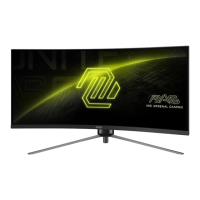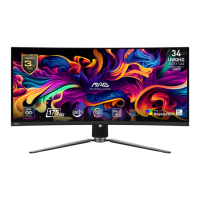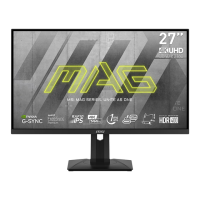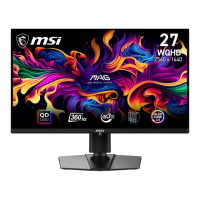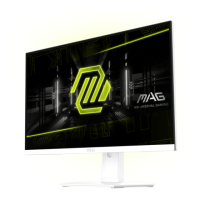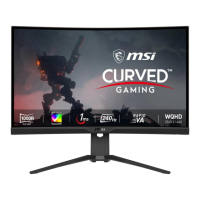Do you have a question about the MSI MAG 323UPF and is the answer not in the manual?
Lists all items included in the monitor package.
Step-by-step guide for attaching the monitor stand.
Instructions for optimizing viewing comfort through tilt and height adjustments.
Identifies and labels all external buttons, ports, and features of the monitor.
Guides on how to connect the monitor to a computer for display output.
Introduction to the On-Screen Display setup and its controls.
Detailed explanation of the Navi Key's functions for OSD navigation.
How to use the Navi Key for quick access to preset functions.
Overview of the main categories within the OSD menu system.
Configuration for Game Intelligence, including KVM and input source switching.
Feature to customize in-game crosshairs using AI algorithms.
Zoom function for precise aiming in games, with adjustable scope settings.
Settings for optimizing the monitor for different game genres and Night Vision.
Adjustments for response time to reduce motion blur in fast-paced games.
Feature to improve motion clarity by synchronizing MPRT with refresh rate.
Options for monitoring and adjusting the screen's refresh rate.
Functionality to set an on-screen alarm timer.
Technology to prevent screen tearing and stuttering in gaming.
Predefined display modes optimized for various professional and entertainment scenarios.
Settings to reduce eye strain by filtering out blue light emissions.
Enhances image quality by increasing contrast in dark scenes.
Adjustments to improve the sharpness and clarity of image edges.
Control for adjusting the screen's brightness level.
Adjusts the difference between the brightest and darkest areas of the image.
Fine-tunes the clarity and detail of image elements.
Options to adjust the color balance and warmth of the display.
Allows adjustment of aspect ratio and resolution for optimal display.
Improves dark scene contrast by dynamically adjusting backlight zones.
Manually select the active video input signal.
Enables simultaneous display of multiple video sources on one screen.
Customization options for the Navi Key's shortcuts.
Selection and confirmation of the OSD menu display language.
Adjusts the opacity level of the OSD menu interface.
Sets the duration the OSD menu remains visible before auto-closing.
Configuration for the monitor's power button behavior in different states.
Toggles the display of monitor status information on the screen.
Settings for enabling HDMI 2.1 features and maximum resolution.
Enables control of connected CEC-compatible devices via HDMI.
Manages the USB Type-C Power Delivery charging function.
Resets all OSD settings back to their factory default values.
Comprehensive technical details including size, resolution, refresh rate, and I/O.
Lists supported resolutions and refresh rates for various standards via HDMI and DP/USB-C.
Provides solutions for common problems like no image, fuzzy screen, or flickering.
General safety guidelines for using the monitor.
Specific safety measures related to the power supply and connection.
Precautions and warnings concerning battery handling and disposal.
Guidelines for safe operation, placement, and cleaning to prevent damage.
Information on TÜV Rheinland Low Blue Light and Flicker Free certifications.
States compliance with European Union directives for EMC, low voltage, ErP, and RoHS.
Details FCC compliance for radio frequency interference.
European Union directive on Waste Electrical and Electronic Equipment.
MSI's commitment to providing chemical substance information.
Declarations regarding hazardous substances compliance for various regions.
Highlights environmentally friendly aspects of the product's design and lifecycle.
MSI's policy on product reuse, recycling, and disposal.
Legal notice regarding copyright, trademarks, and MSI's rights.
Information on how to obtain technical assistance and support for the product.
Lists all items included in the monitor package.
Step-by-step guide for attaching the monitor stand.
Instructions for optimizing viewing comfort through tilt and height adjustments.
Identifies and labels all external buttons, ports, and features of the monitor.
Guides on how to connect the monitor to a computer for display output.
Introduction to the On-Screen Display setup and its controls.
Detailed explanation of the Navi Key's functions for OSD navigation.
How to use the Navi Key for quick access to preset functions.
Overview of the main categories within the OSD menu system.
Configuration for Game Intelligence, including KVM and input source switching.
Feature to customize in-game crosshairs using AI algorithms.
Zoom function for precise aiming in games, with adjustable scope settings.
Settings for optimizing the monitor for different game genres and Night Vision.
Adjustments for response time to reduce motion blur in fast-paced games.
Feature to improve motion clarity by synchronizing MPRT with refresh rate.
Options for monitoring and adjusting the screen's refresh rate.
Functionality to set an on-screen alarm timer.
Technology to prevent screen tearing and stuttering in gaming.
Predefined display modes optimized for various professional and entertainment scenarios.
Settings to reduce eye strain by filtering out blue light emissions.
Enhances image quality by increasing contrast in dark scenes.
Adjustments to improve the sharpness and clarity of image edges.
Control for adjusting the screen's brightness level.
Adjusts the difference between the brightest and darkest areas of the image.
Fine-tunes the clarity and detail of image elements.
Options to adjust the color balance and warmth of the display.
Allows adjustment of aspect ratio and resolution for optimal display.
Improves dark scene contrast by dynamically adjusting backlight zones.
Manually select the active video input signal.
Enables simultaneous display of multiple video sources on one screen.
Customization options for the Navi Key's shortcuts.
Selection and confirmation of the OSD menu display language.
Adjusts the opacity level of the OSD menu interface.
Sets the duration the OSD menu remains visible before auto-closing.
Configuration for the monitor's power button behavior in different states.
Toggles the display of monitor status information on the screen.
Settings for enabling HDMI 2.1 features and maximum resolution.
Enables control of connected CEC-compatible devices via HDMI.
Manages the USB Type-C Power Delivery charging function.
Resets all OSD settings back to their factory default values.
Comprehensive technical details including size, resolution, refresh rate, and I/O.
Lists supported resolutions and refresh rates for various standards via HDMI and DP/USB-C.
Provides solutions for common problems like no image, fuzzy screen, or flickering.
General safety guidelines for using the monitor.
Specific safety measures related to the power supply and connection.
Precautions and warnings concerning battery handling and disposal.
Guidelines for safe operation, placement, and cleaning to prevent damage.
Information on TÜV Rheinland Low Blue Light and Flicker Free certifications.
States compliance with European Union directives for EMC, low voltage, ErP, and RoHS.
Details FCC compliance for radio frequency interference.
European Union directive on Waste Electrical and Electronic Equipment.
MSI's commitment to providing chemical substance information.
Declarations regarding hazardous substances compliance for various regions.
Highlights environmentally friendly aspects of the product's design and lifecycle.
MSI's policy on product reuse, recycling, and disposal.
Legal notice regarding copyright, trademarks, and MSI's rights.
Information on how to obtain technical assistance and support for the product.
| Color gamut | 95 % |
|---|---|
| Pixel pitch | 0.1845 x 0.1845 mm |
| Aspect ratio | 16:9 |
| Screen shape | Flat |
| Display diagonal | 32 \ |
| Display technology | - |
| Vertical scan range | 48 - 160 Hz |
| Maximum refresh rate | 160 Hz |
| Horizontal scan range | 180 - 352 kHz |
| Supported video modes | 2160p |
| Viewable size, vertical | 398.52 mm |
| sRGB coverage (typical) | 125.7 % |
| Contrast ratio (dynamic) | 100000000:1 |
| Contrast ratio (typical) | 1000:1 |
| Display number of colors | 1.07 billion colors |
| Display diagonal (metric) | 81.28 cm |
| Viewable size, horizontal | 708.48 mm |
| Display brightness (typical) | 440 cd/m² |
| Supported graphics resolutions | 3840 x 2160 |
| HDMI | Yes |
| USB hub version | 2.0 |
| Headphone outputs | 1 |
| DisplayPort version | 1.4a |
| USB upstream port type | USB Type-B |
| USB Type-A downstream ports quantity | 3 |
| Input current | 4.74 A |
| AC input voltage | 100 - 240 V |
| AC input frequency | 50/60 Hz |
| Energy efficiency scale | A to G |
| AC adapter output voltage | 19 V |
| Power consumption (standby) | - W |
| Package depth | 168 mm |
| Package width | 975 mm |
| Package height | 550 mm |
| Package weight | 12500 g |
| Tilt angle range | -5 - 20 ° |
| Height adjustment | 100 mm |
| Cable lock slot type | Kensington |
| Panel mounting interface | 100 x 100 mm |
| Product color | Black |
| Market positioning | Gaming |
| AMD FreeSync type | FreeSync Premium |
| Depth (with stand) | 233.7 mm |
|---|---|
| Width (with stand) | 727.1 mm |
| Height (with stand) | 494.9 mm |
| Weight (with stand) | 9700 g |
| Depth (without stand) | 72.9 mm |
| Height (without stand) | 432.4 mm |
| Weight (without stand) | 6800 g |


